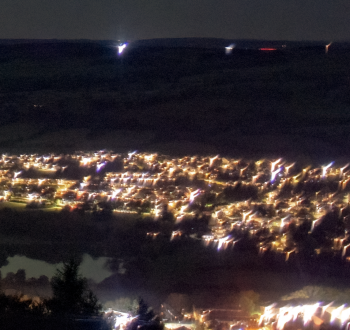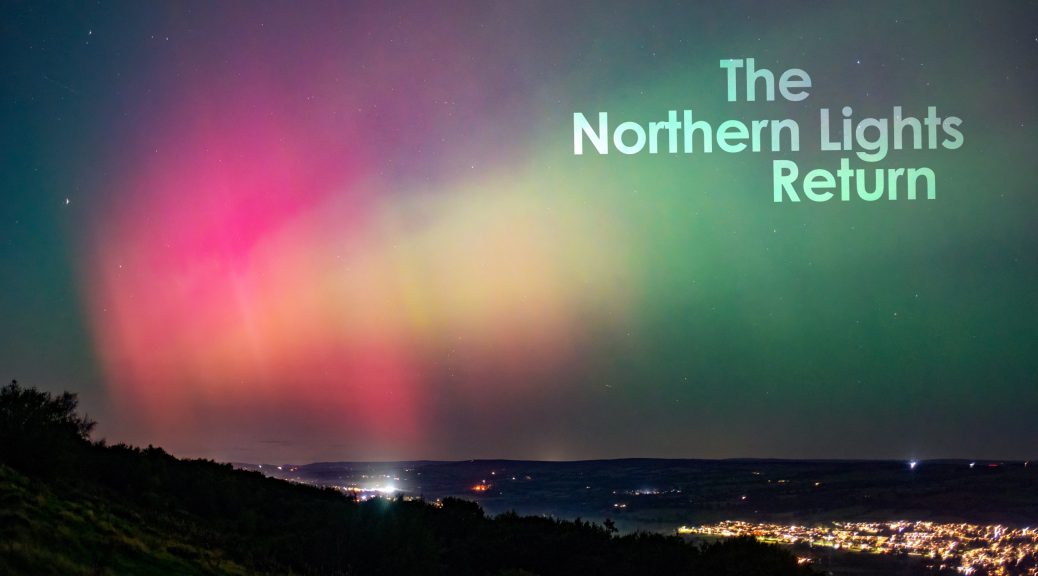Again, again!
As you are no doubt aware, and are even likely to have witnessed, on October 10th we saw another amazing display of the Northern Lights here in the UK. For some, myself included, this rivalled and even exceeded the spectacle we experienced in May. In May I could see the lights but, to my naked eye, they appeared as grey wispy clouds only really showing their true chromatic beauty on camera. In October, however, the display was active enough that I could even see the colours without the assistance of the camera.
300-image timelapse sequence of the aurora on October 10th
With thanks to my friend Lauren, who I met on Otley Chevin and with whom I have become friends through chasing the aurora, I had a solid heads-up about the prospect of a potentially strong display a good few hours ahead of the event. She and I had become confident that an event was imminent and, although we have prospected on numerous occasions and faced levels of disappointment, the information we had gathered was extremely promising. We arrived at a deserted Otley Chevin around 8pm. By the time I took my last photo of the evening, around 10:30pm, word had spread so widely and the area had become so inundated by spectators that I had to queue for several minutes just to get off the Chevin.
But on reflection my images are something of a disappointment.
Lessons
In May, I learned some lessons about photographing the Northern Lights. In October, I failed to learn FROM some of those lessons. There are reasons, however. Or excuses, if you prefer…
1 – Preparation
Although in May the temperature wasn’t notably bad – I don’t remember freezing my butt off – I know all too well that at night it can get cold, especially in October! I had hand warmers with me, but only one of them had charge. It was enough to get through, but it could have been more comfortable with two fully charged handwarmers.
My feet, though, were insanely cold. Being diabetic, my extremities are of course extremely susceptible to the cold. In spite of this I was wearing cheap shoes and the kind of thin cotton socks I’d wear with slippers. Not the kind of footwear anyone, least of all a diabetic, should be wearing on Otley Chevin. This is the primary reason my evening ended far earlier than it should have.
2 – Foreground interest
The biggest lesson I failed to learn in May was the importance of foreground interest in a photograph. I’d had all kinds of ideas for locations, including the church in Blubberhouses by the side of the A59, the reservoirs Swinsty and Fewston.. but instead resorted to the default location, the easily accessed and local locale, the Chevin. Fearing that I’d miss too much of the spectacle unfolding above us, I never budged from the Chevin until I was too cold to remain.
3 – Persistence
I failed to persist in the endeavour. Knowing that I had work in the morning, and with my feet being frozen to the bone (quite literally), I chose to go home to warm up and look at the images that I’d captured, even as the event was still unfolding outside. Nothing prevented me from sitting in the car for half an hour with the heater blowing toasty warm air at my feet. I could even have driven to a new location while I was warming through. But I didn’t. I just decided, for whatever inexplicable reason, to go home. It’s criminal and I’m thoroughly ashamed.
4 – My kit bag
I wanted to vary the focal lengths in the images that I got, and started out with my new 85mm f/1.8. However, the position of the aurora in the sky, relative to the horizon, initially didn’t suit this lens.

I quickly switched to the 24mm f/2.8 but was horrified by the coma in the corner of images it produced. As much as I love this lens otherwise, I’ll never again attempt astrophotography with the AF 24mm f/2.8. It’s shocking.
Fortunately I did have my Samyang 14mm f/2.8 in the boot, attached to my infrared-converted D3000. I nipped back to the car while Lauren guarded my camera and tripod and retrieved it. The Samyang does do an astoundingly good job, I have to say, and most especially compared with my other lenses it’s a tremendous bang for your buck. Even though it’s manual focus, being 14mm, it barely needs focusing anyway. It works great for infrared photography and works amazingly for astrophotography too. As the display spread across the sky, the 14mm captured as much of it as I could have wished.
What I didn’t do, and it’s something that I deeply regret, is to set up my D5300 for a timelapse of the aurora. The D5300 has a built-in intervalometer but in the heat of the moment I even have a locking remote cable release, and could have had it merrily ticking away at the sky in minutes. But I didn’t even bring it with me! I have 2 tripods and enough lenses between my cameras that the D5300 could have been on its own mission while I shot away separately with the D800. What’s the point in having all the bells and whistles if you’re too slack to take them with you, when they could so obviously have come into their own!? It’s a rhetorical question, obvs.
In conclusion, for now…
I need to concentrate on learning the lessons I teach myself, and I need to up my game more. I captured some images that I’m pretty pleased with but, viewing my images objectively, I haven’t distinguished myself at all from many of the people who were simply using smartphones on the night.
The 11-year cycle won’t last forever! By the end of the first quarter of 2025, the likelihood of another display like we’ve seen twice this year will become vanishingly small. I knew before the 10th October event what I needed to do to make an outstanding image, but in the moment I think on some level I panicked and forgot almost everything I thought I’d trained myself to do.
I need to be objective in the instant, and ask myself if the things I’m doing are going to lead me to simply capture an image of the aurora borealis or, alternatively, if my plan is to exploit the aurora borealis in order to capture a stunning image that stands out from the crowd. If I don’t plan and prepare more effectively – including equipment checklists, a list of potential locations, and appropriate footwear – then I fear I’m destined to perpetually capture mediocre, samey images of the northern lights.
And this, of course, is assuming that I even get another opportunity like this. Living in the UK implicitly means living under a cloud. The combination of the northern lights on a night with a clear sky, here in the British Isles, is anything but commonplace. I’ll count myself extremely lucky if I get another opportunity to fail so spectacularly as I did this time around.









